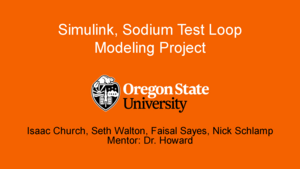
Sodium is a material of interest for reactor systems due to its high thermal conductivity and boiling point. These factors combined with its low neutron moderation and absorption make it a very desirable material for advanced reactor systems, allowing for higher temperatures and lower pressures than traditional reactors. Sodium fast reactors operate at 500 ℃, nearly double the operating temperature of current commercial reactors leading to greatly increased thermodynamic efficiency. Additionally, their primary coolant loops operate near atmospheric pressure, so explosions due to pressure vessel failures are impossible. However, sodium is an extremely reactive element, especially in its liquid state. Interactions between sodium and water are highly exothermic and can result in fires or explosions. These reasons make it clear that the thermodynamic properties must be well modeled and understood to prevent accidents in existing and future facilities.
The GELS facility at Oregon State is currently under construction, and will be used to test sodium properties and verify the accuracy of the Simulink model once completed. Using Simulink, a modeling software library within MATLAB, our team has developed a thermodynamic model out of piping and instrumentation diagrams (P&ID’s) of the GELS loop. The loop simulation is capable of accurately modeling the temperature and pressure of the sodium at each point in the loop, as well as mass flow rates and other flow behavior. Simulink models this by iteratively running pipe and fluid flow equations based on user-defined component blocks and fluid properties. After an accurate model of the existing system is created, a scaled system representative of conditions found in full-scale sodium reactor systems can be developed, allowing for full-scale simulation without risking sodium accidents. The model can also run more iterations of tests in the same amount of time when compared to the GELS loop; the model can also be altered to test different conditions of the GELS loop without having to manipulate the facility.
| Attachment | Size |
|---|---|
| 1.04 MB | |
| 150.31 KB | |
| 226.5 KB |

